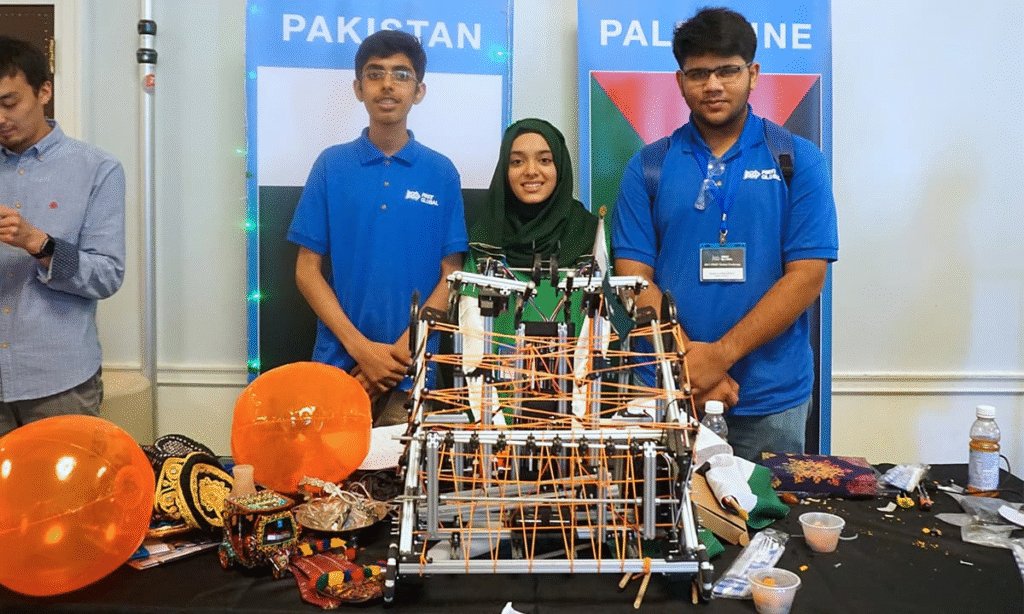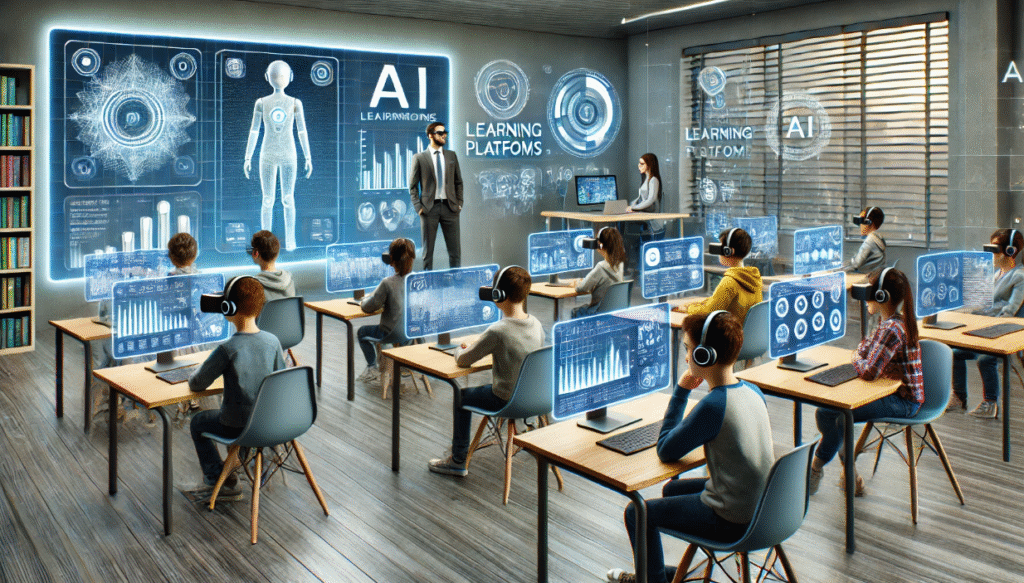Education is the bedrock of every nation’s development, and now in 2025, Pakistan is poised to take the first step forward into an educational revolution. With Artificial Intelligence (AI) and Robotics now in classrooms, the educational experience of Pakistani students, their teachers and education systems has changed forever.
At PresentPakistan.com, we believe in the development stories of Pakistan. The integration of AI and robotics into education is about more than machines; it is about preparing our youth for the future while building a knowledge-based economy, and making sure Pakistani students are able to compete worldwide.

The Present Situation of Education in Pakistan
Pakistan’s education system has long faced challenges, including the application of a stagnant curriculum, weak infrastructure and an urban to rural divide. Over 22 million children are out of school in Pakistan according to UNICEF, but the growth of digital learning platforms, the government is reforming the education system, and private EdTech start-ups are opening new doors.
AI and Robotics could be a significant part of that change. If we can change from just rote learning to smart, skills-led education that creates creativity, problem-solving abilities and innovation, there is more chance for equality of educational opportunity in Pakistan.
What are Artificial Intelligence and Robotics in Education?
AI in education incorporates smart technologies that look at student learning trends, customize learner’s journey for individual students and performs assessments. Robotics Educational programming focuses on teaching children how to design, build and program robots while learning hands-on STEM (Science, Technology, Engineering, and Mathematics).
To give you some examples, AI and Robotics are already being utilized throughout the globe:
- Offer virtual tutors, which assist individual students.
- Build robotics labs, where students learn innovation through real-world projects.
- Utilize data insights, to follow student learning progress.
For students in Pakistan, learning is going beyond textbook learning – interactive, personalized, skills added.

Worldwide Trends in AI and Robotics Education
Countries like China, the USA and South Korea and Finland are already beginning to use AI and have robotics as STEM education in classrooms. According to UNESCO, by 2022, 65% of the students now in our schools will engage in jobs that don’t yet exist (many of which will be related to AI and robotics).
Here’s a brief summary of how these countries introduced AI into their curriculum or even created a new subject of robotics:
- China introduced an AI curriculum into the school system prior to 2018.
- South Korea included robotics in their early education curriculum as a way to inspire innovation.
- Finland adopted AI in its curriculum which was designed to provide AI-based personalized learning for every student.
Pakistan cannot afford to not be a player in this global educational shift.
Pakistan’s Entrance into the AI & Robotics Era
Pakistan is in motion. The following items are worth mentioning:
- Governmental Initiatives
- In 2023, Pakistan created a National AI Policy, which is intended to serve as a policy roadmap to the adoption of AI in education, agriculture and governance.
- Many universities (NUST, LUMS, PIEAS among many others) are developing universities which include AI & robots labs.
- Private Sector and Start-Up Activities
- LearnOBots (Islamabad) is giving away robotics kits free of charge to school and students across Pakistan.
- Digital education platforms Edkasa and Sabaq are providing AI-enabled learning opportunities.
- Robotic Competitions
Pakistani students have participated in the FIRST Robotics competitions and have been recognized all over the world for their participation.

Benefits of AI & Robotics for Students in Pakistan
AI and robotics are not “shiny devices”; they are game-changing educational tools. Benefits include:
- Personalized Learning: AI provides a unique lesson to each student with each lesson and at each speed.
- Intelligent Assessment: Automated assessment improves grading and provides immediate feedback.
- STEM Skills: Robotics develop creativity, coding, & problem-solving.
- Employment: AI & robotics will provide millions of new job opportunities to communities around the world by 2030. Pakistani youth can help make-up this new workforce.
- Closing the Urban-Rural Divide: AI-based platforms provide education to students in rural, remote, to urban situations where quality teachers do not exist.
Challenges to Implementation of AI & Robotics in Pakistan
There is some momentum forward but there are many challenges:
- Infrastructure Gaps – many schools do not have electricity and/or connectivity.
- Teacher Training Gaps – Almost all teachers have little or no experience with AI-driven vehicles.
- Urban-Rural Divide – Big cities have robotics labs while many small villages do not.
- Pricing – Robotic kits and AI Platforms can be costly.
If Pakistan wants to form real change for communities, it is going to take some real commitment to training, infrastructure and accessibility.
Case Studies & Examples from Pakistan
- NUST’s Robotics Lab has developed drones, medical robots, and AI systems.
- AI Lab at LUMS is doing research and development of AI-based solutions for governance in the health and education domains.
- LearnOBots trained thousands of school children in robotics.
- Beaconhouse Schools is also implementing AI-powered learning management systems across Pakistan in its schools.
These examples are a reminder that Pakistan is not behind. It is slowly coming up to global standards.
The Future of AI & Robotics in Pakistani Education (2025 and Beyond)
- By 2025 and beyond, we can expect to see:
- AI-driven classrooms with digital assistants employed to enhance teacher-provided instruction.
- Robotics in K-12 schools to teach STEM to every student.
- Virtual reality (VR) and AI tutors to instruct students on an individual basis.
Students and freelancers in Pakistan with knowledge and skill in AI/robotics are likely to have more career and payment opportunities.
.

Contributions of Individuals, Educators, & Policymakers
All role players have a role in the success of a country like Pakistan:
- Teachers should have training in programs in AI/robotics.
- Parents should support children using robotics and coding.
- Policymakers provide funding to help create the infrastructure and ensure that everyone has the same access.
Conclusion
AI and robotics are not simply luxuries; they are vital to the future of Pakistan. The wise use of these technologies will change learning, innovate, and position millions of Pakistani students to engage in the global knowledge economy.
Would you like to keep up with Pakistan’s latest education, technology and innovation trends?
Check in with PresentPakistan.com every day for new perspectives and stories to inspire you.
Frequently Asked Questions
Q1: How is AI currently being applied to education in Pakistan?
AI is facilitating personalized learning, facilitating the completion of assessment/marking, and increasing efficiency in higher education.
Q2: In what ways do robotics labs provide students from Pakistan with a competitive advantage?
They provide real-life experiential learning opportunities in coding, engineering, and innovation.
Q3: Is Pakistan ready for AI-enabled classrooms?
Yes, however, we will need to upskill teachers and invest in infrastructure.
Q4: What obstacles does Pakistan face to implementing AI in education?
The obstacles are infrastructure, teacher training, and cost.
Q5: How will AI & Robotics impact the future job opportunities in Pakistan?
They will prepare the youth for possible global careers in AI, engineering, or automation.
People Also Ask
Q1: How does AI is changing the educational system in Pakistan?
AI is changing the educational system in Pakistan, with personalized learning tools, smart assessment systems and virtual tutoring platforms. In a more traditional model of education, the educational model above is more used than other options. One of the positive educational impacts of AI is that it begins to explore the unique strengths and weaknesses of the student rather than fit the learner into a box or prescribed level of education in the more traditional model. In Lahore and Islamabad, AI powered systems are being tested to assist in studying the learning changes and digital literacy within the education context.
Q2: What are the benefits of robotics to the Pakistani student?
Robotics provides the hands-on STEM experience (Science, Technology, Engineering, Mathematics) to the Pakistani student by building and programming a robot, it also teaches problem solving, action planning, and pertinent skills related to teamwork and innovation. A robotics lab can also impact the develop critical thinking and essential foresights that begin to prepare the youth for careers in the future such as engineering, AI and the automation industry.
Q3: Which universities in Pakistan are actively involved in teaching AI and robotics?
There are some of the top Universities in Pakistan which are actively involved in teaching AI and robotics including:
- NUST (National University of Sciences and Technology) – AI & Robotics labs.
- LUMS (Lahore University of Management Sciences) – AI research centers.
- PIEAS (Pakistan Institute of Engineering and Applied Sciences) – Robotics & Automation as their main focus.
- FAST-NUCES – has an AI program and computer science program.
These institutions are successfully achieving their objective to make their students competitive at a global level.







